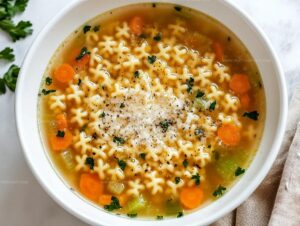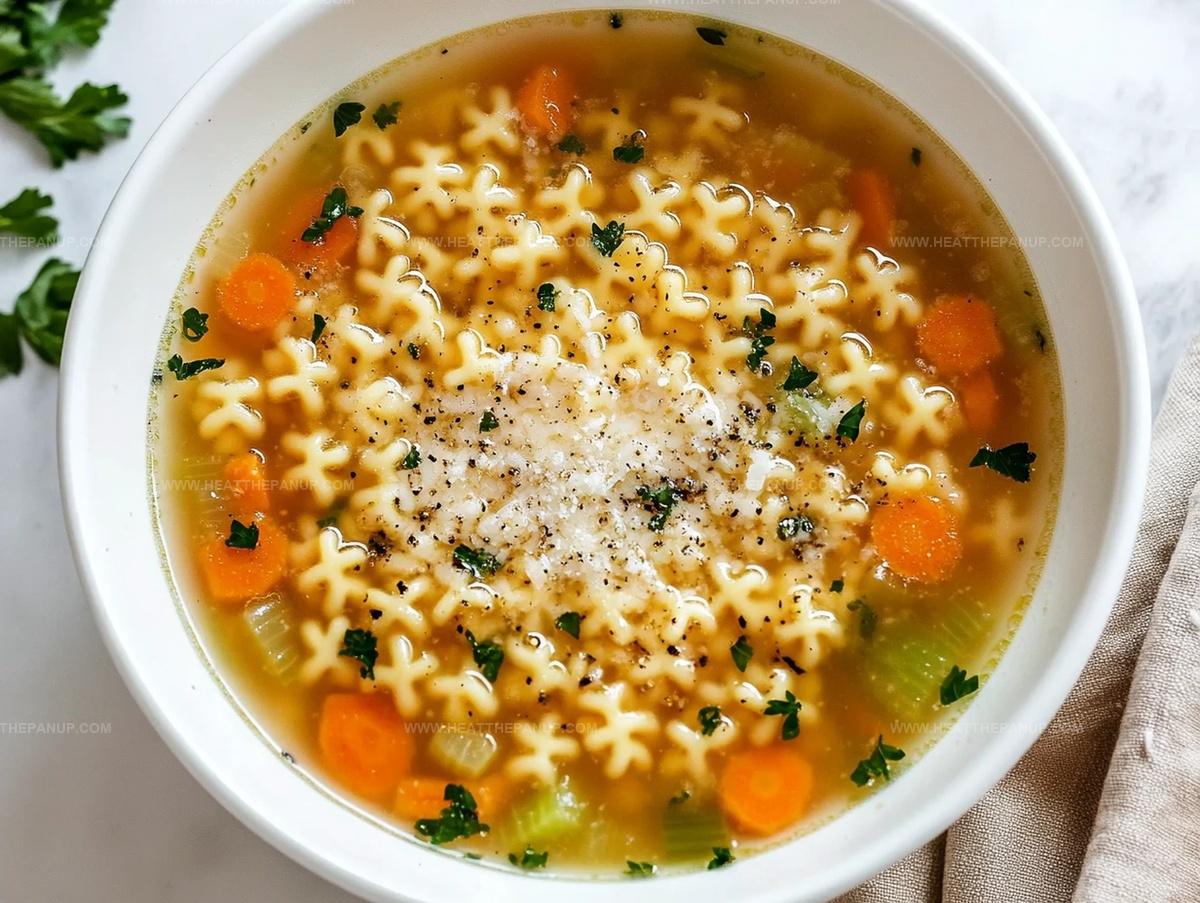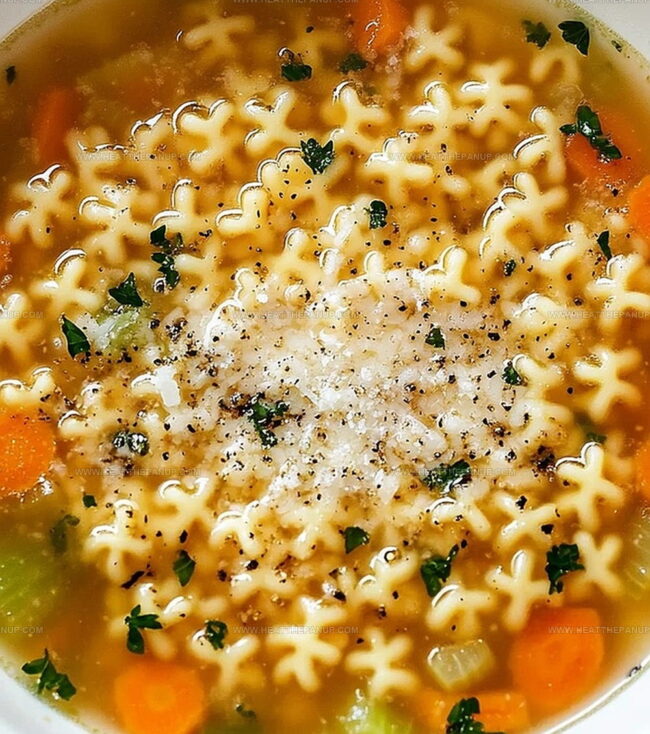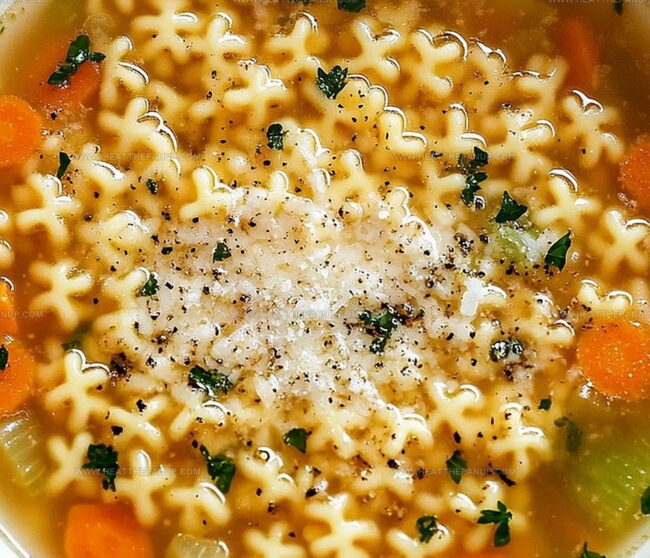Easy Pastina Soup Recipe: Heartwarming Comfort in a Bowl
Comfort arrives in the smallest pasta shapes with pastina soup, a classic Italian remedy that warms hearts and soothes souls.
Delicate, tiny pasta pearls dance in a rich, golden broth that whispers memories of grandmother’s kitchen.
Every spoonful carries the essence of simplicity and love, crafted with just a few humble ingredients.
Italians have long treasured this soothing dish as a go-to meal during chilly days or when feeling under the weather.
The soup’s gentle nature makes it perfect for children and adults alike, offering nourishment and pure culinary comfort.
Creamy and light, this soup promises a healing embrace that feels like a warm hug from the inside out.
Prepare to fall in love with this timeless, soul-satisfying recipe that connects generations through its delicious simplicity.
What Makes Pastina Soup So Comforting
Ingredients for a Cozy Bowl of Pastina Soup
Vegetables:Pasta:Liquid Base:Cheese and Herbs:Seasonings:Finishing Touches:How to Make This Classic Pastina Dish
Step 1: Awaken the Vegetables
Warm a spacious pot over medium heat and drizzle in olive oil.
Add onions, carrots, celery, and garlic.
Let them dance and soften for 5-7 minutes, stirring occasionally until they release their aromatic magic.
Step 2: Build Flavor Foundation
Pour in chicken or vegetable broth and introduce the Parmesan rind.
Bring the liquid to a gentle boil, then lower the heat.
Allow the ingredients to whisper their flavors together for 15-20 minutes.
Step 3: Welcome the Tiny Pasta
Gently sprinkle pastina into the simmering broth.
Cook according to package guidance, typically 6-8 minutes, stirring frequently to prevent pasta from clinging to the pot’s bottom.
Aim for tender, pillowy pasta.
Step 4: Perfect the Seasoning
Remove the Parmesan rind.
Taste and adjust with salt and black pepper, creating a balanced flavor profile that sings.
Step 5: Serve with Love
Ladle the steaming soup into welcoming bowls.
Tips for a Creamy, Simple Soup
How to Store and Heat Up Pastina Soup
Pairing Ideas for Italian Pastina Soup
Pair Perfectly with Pastina Soup:Fresh Ways to Serve Pastina Soup
FAQs
Pastina is the smallest type of pasta, typically star-shaped or tiny round pieces, commonly used in Italian soups and as a first food for babies. It’s delicate, quick-cooking, and absorbs flavors beautifully.
Yes, you can substitute chicken broth with vegetable broth or even beef broth depending on your preference. Each will provide a slightly different flavor profile to the soup.
Absolutely! Pastina soup is packed with vegetables, provides protein from broth, and offers complex carbohydrates from the pasta. It’s a balanced, light meal that’s especially comforting when you’re feeling under the weather.
You can add shredded cooked chicken, small diced ham, or white beans to increase protein and make the soup more substantial. These additions will transform the light soup into a more hearty meal.
Print
Pastina Soup Recipe
- Total Time: 40 minutes
- Yield: 4 1x
Description
Italian comfort calls to home cooks with this heartwarming pastina soup, a nostalgic embrace of simple ingredients dancing in savory broth. Childhood memories mingle with warmth, inviting you to savor each spoonful of pure, soulful nourishment.
Ingredients
Pasta and Broth:
- 1 cup pastina (tiny star-shaped pasta or any small pasta shapes)
- 6 cups low-sodium chicken or vegetable broth
- 1 Parmesan rind (optional, for added depth of flavor)
Vegetables and Aromatics:
- 1 medium yellow onion, chopped
- 2 carrots, peeled and chopped
- 2 celery stalks, chopped
- 4 garlic cloves, minced
Seasonings and Garnishes:
- Salt, to taste
- Black pepper, to taste
- Fresh parsley, chopped (for garnish)
- Grated Parmesan cheese (for garnish)
- Extra virgin olive oil (for drizzling)
Instructions
- Warm olive oil in a spacious pot over medium flame, introducing diced onions, carrots, celery, and minced garlic. Gently sauté the vegetables for approximately 5-6 minutes until they become translucent and release their aromatic essence.
- Stream chicken or vegetable broth into the vegetable mixture, incorporating the Parmesan rind for enhanced depth. Elevate the liquid to a rolling boil, then immediately reduce to a gentle simmer. Allow the ingredients to harmonize and develop rich flavors for 15-20 minutes.
- Introduce pastina into the simmering broth, stirring consistently to prevent clumping. Cook the tiny pasta until it reaches a tender consistency, typically requiring 6-8 minutes of careful attention.
- Carefully extract and discard the Parmesan rind. Taste the soup critically, adjusting seasoning with salt and freshly ground black pepper to create a balanced flavor profile.
- Transfer the steaming soup into serving bowls with a ladle. Embellish each portion with a sprinkle of freshly chopped parsley, a generous dusting of grated Parmesan cheese, and a delicate drizzle of extra virgin olive oil to elevate the dish’s visual and gustatory appeal.
Notes
- Select small pastina shapes like stelline or orzo for the most authentic and child-friendly texture.
- Use homemade chicken stock for richer, deeper flavor complexity that elevates the entire soup’s taste profile.
- Consider replacing chicken broth with vegetable broth to create a vegetarian-friendly version that’s equally comforting.
- Add beaten egg during final cooking stage for extra protein and traditional Italian “stracciatella” style texture, whisking gently while pouring to create soft egg ribbons throughout the soup.
- Prep Time: 10 minutes
- Cook Time: 30 minutes
- Category: Lunch, Dinner, Appetizer
- Method: Sautéing
- Cuisine: Italian
Nutrition
- Serving Size: 4
- Calories: 150
- Sugar: 2g
- Sodium: 300mg
- Fat: 3g
- Saturated Fat: 1g
- Unsaturated Fat: 2g
- Trans Fat: 0g
- Carbohydrates: 28g
- Fiber: 2g
- Protein: 5g
- Cholesterol: 5mg




James Hambly
Founder & Recipe Creator
Expertise
Recipe Development, Culinary Education, Farm-to-Table Cooking, Southern Cuisine
Education
Asheville-Buncombe Technical Community College
Certificate in Culinary Arts
Focus: Hands-on training in professional cooking techniques, emphasizing farm-to-table practices and Southern cuisine.
The Chef’s Academy
Associate Degree in Culinary Arts
Focus: Comprehensive culinary education covering global cuisines, kitchen management, and food safety.
James grew up surrounded by the smells of cast-iron skillets and slow-cooked Southern meals in Asheville, North Carolina.
He sharpened his skills with a Certificate in Culinary Arts from Asheville-Buncombe Technical Community College, and later leveled up with an Associate Degree from The Chef’s Academy.
James’s philosophy is simple: the best meals don’t need fancy tricks, just fresh ingredients, a hot pan, and a little bit of heart. His favorite days are spent testing one-pan wonders, chasing bold flavors, and creating recipes that feel easy, even on a busy night.